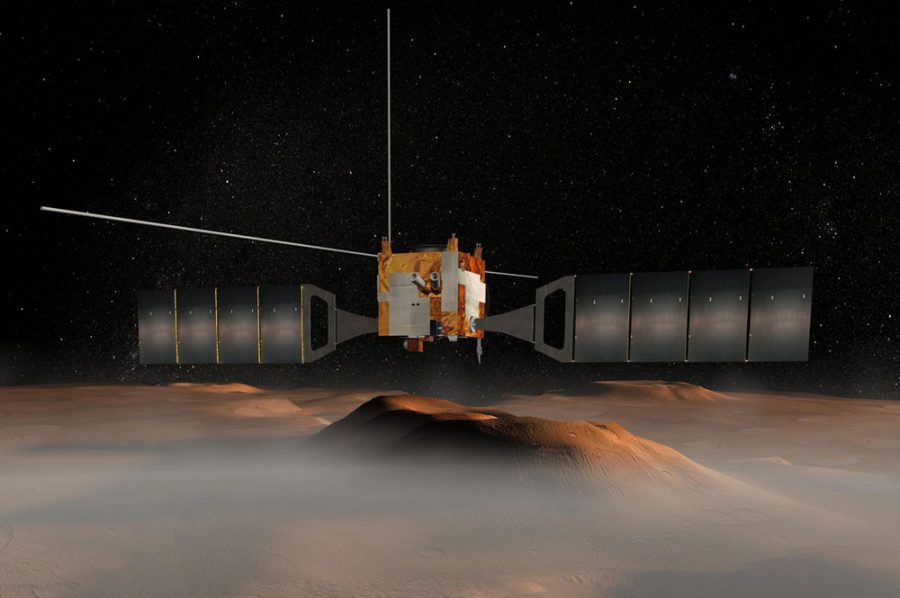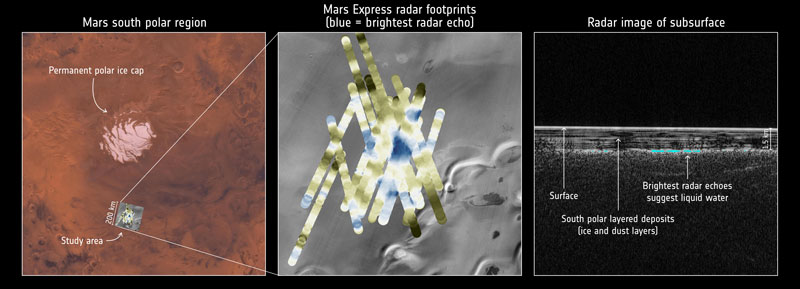7.07.2021
Astronomers find more bright spots underneath Mars’s south polar cap, but could they really be subterranean lakes?

Astronomers have wondered about the nature of the Martian polar caps for centuries and, despite recent studies, the mystery continues. For example, the discovery of a large radar-bright area deep beneath the South Polar Layered Deposits (SPLD) — large layers of dry and water ice plus sediment deposited over millions of years at Mars’s south pole — suggested the presence of a huge subterranean lake. Now more of these bright spots have been identified beneath the SPLD, but could they really be pockets of liquid water? Researchers aren’t so sure.
In 2018, Roberto Orosei and colleagues at the National Institute of Astrophysics (Italy) found the large radar-bright area, 1.3 km (0.8 mi) below the surface, using a radar experiment called MARSIS on the European Space Agency’s Mars Express orbiter. In a study published in the June Geophysical Research Letters, Aditya Khuller (Arizona State University) and Jeffrey Plaut (NASA’s Jet Propulsion Laboratory) used the same instrument to map the SPLD in greater detail. The MARSIS radar penetrates meters to a few kilometers beneath the surface, depending on composition – that’s deep enough to chart the boundary where the polar deposits end and the Martian interior begins. Khuller and Plaut’s investigation of this interface revealed dozens of new smaller regions, like the one found by Orosei’s team.

ESA/NASA/JPL - Caltech
Initially, the radar-bright features were assumed to be caused by large differences in the dielectric permittivity (a measure of a material’s response to an electric field) between two juxtaposed materials. Since liquid water has a high dielectric permittivity, Orosei’s team concluded that a large pocket of salty liquid was responsible for the bright MARSIS reflections. Even though the subsurface temperatures on Mars drop far below the freezing point of pure water, a concentrated brine (water containing large amounts of dissolved salts) can stay liquid at lower temperatures. Still, some astronomers suggest that Mars is too cold to host even a briny subterranean lake.
JUST TOO COLD FOR LIQUID WATER?
The case for a subsurface lake weakened in 2019, when Michael Sori and Ali Bramson (University of Arizona) suggested that the heat produced within the Martian interior is less than half that needed to keep even the saltiest water from freezing. If liquid water is present, then some sort of localized magmatism in the recent past, deep below Mars’s surface, must be providing enough extra heat to keep the fluid from freezing — and there’s no geologic evidence for that.
But recent work published in Nature Astronomy challenges the need for chambers of magma. Sebastian Lauro (National Institute of Astrophysics, Italy) and his team, which includes Orosei, likewise found additional bright spots in MARSIS data. Additionally, their assessment shows that the most reflective areas along the deep SPLD boundary are also the smoothest, mimicking the characteristics of lakes buried beneath Greenland’s ice sheet. Despite the polar temperatures, they point out that brines can become salty enough to exist in a metastable state, allowing them to stay liquid well below their normal freezing points.

Context map: NASA / Viking; THEMIS background: NASA / JPL-Caltech / Arizona State Univ.; MARSIS data: ESA / NASA / JPL / ASI / Univ. Rome; R. Orosei et al 2018
These findings, like many, invite healthy speculation: “Bright reflectors are telltale signs of the possible presence of water, but we never automatically equated them with liquid water,” say Orosei and Lauro, along with colleague Elena Pettinelli. “The discovery of other areas with strong basal reflectivity is hugely important to understand how the existing evidence of liquid water and the difficulty of explaining its presence from a theoretical point of view can be reconciled.”
THE CASE FOR A DIFFERENT CULPRIT
The dozens of new radar-bright locations discovered by Khuller and Plaut are widespread and independent of the thickness of the overlying ice deposits. “Clearly, this behavior is not unique, and these regions are quite common under the south pole,” says Khuller. Some researchers find it hard to believe that underground briny lakes could be so ubiquitous. In fact, a new study from a team led by Carver Bierson (Arizona State University), also in the June Geophysical Research Letters, suggests that super-salty liquid water isn’t the only thing that could match the MARSIS data.
Bierson’s team uses simulations to show that, in addition to substances with large dielectric permittivity, highly conductive materials can strongly reflect radar energy as seen in the MARSIS data. Such materials could include hydrated (OH-bearing) clays and salt-rich ice. Furthermore, the MARSIS data show that whatever material lies at the base of the SPLD exhibits different radar reflectivity when probed at different frequencies, which is a hallmark of conductive materials.

A. R. Khuller & J. J. Plaut / The Geophysical Research Letters 2021
Saline ice is a worthy candidate, though it is unclear if salty ice underneath the SPLD could remain conductive enough at such cold temperatures to cause the bright reflections. The most likely explanation, according to Bierson, appears to be mineralogical – metallic ores (like iron oxides) and hydrated clays, both of which are found on the Martian surface, could cause the observed brightening. “Because of the extremely cold temperatures at Mars’s poles, maintaining even very salty water at the base of the ice cap requires some special local heat source,” says Bierson. “In contrast, no special conditions are needed to maintain salt-rich ice, conductive minerals, or clays.” While hydrated clays don’t require lakes of briny liquid, they do imply liquid water was present at some time in the not-so-distant past.
Khuller and Plaut say they too favor an alternate explanation for the bright regions below the SPLD – in part because some of the new radar-bright areas are so close to the surface that even the saltiest brine could not withstand the frigid Martian temperatures. “Instead [of lakes], it seems more likely that other materials, such as those containing clays, are present, buried in the old, Noachian (4 billion years ago) terrain below the ice deposits,” says Khuller.
Whether or not there is liquid water lurking below the Red Planet’s south polar region, these new Martian maps and analyses add valuable information to the pursuit. According to Orosei, “The systematic search and mapping completed by Khuller and Plaut will allow us to zoom in the areas of interest and thoroughly investigate them.”
Quelle: Sky&Telescope
